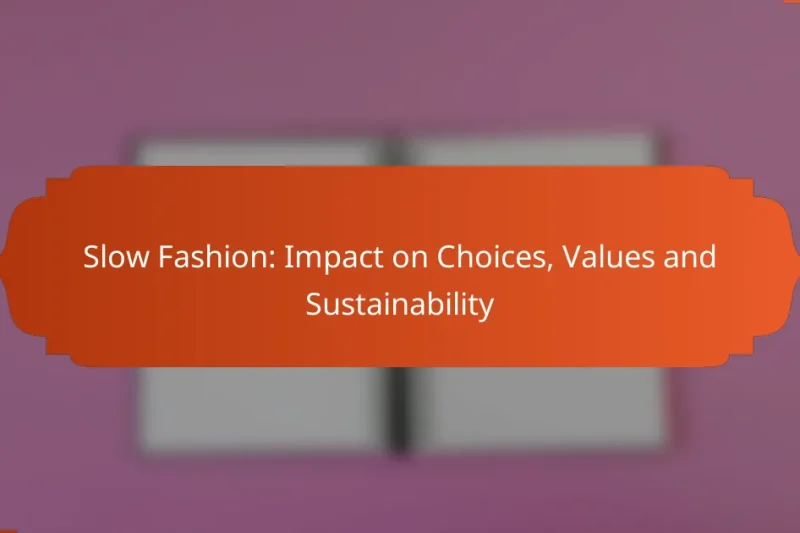The future of sustainable fashion is set to embrace circularity, biodegradable materials, and the growth of … Future of Sustainable Fashion: Predictions, Trends and Eco-Conscious ChoicesRead more
Current Trends in Sustainable Fashion
The current trends in sustainable fashion highlight a growing commitment to eco-friendly practices and ethical production methods. As consumers become more aware of their purchasing impact, brands are responding by adopting innovative materials and transparent supply chains. This shift not only reduces environmental harm but also fosters a culture of social responsibility within the industry.
Minimalism in Sustainable Fashion: Benefits, Trends and Consumer Appeal
Minimalism in sustainable fashion promotes a thoughtful approach to clothing consumption, emphasizing quality over quantity. By … Minimalism in Sustainable Fashion: Benefits, Trends and Consumer AppealRead more
Slow Fashion: Impact on Choices, Values and Sustainability
Slow fashion is reshaping consumer behavior by encouraging a thoughtful and intentional approach to clothing purchases. … Slow Fashion: Impact on Choices, Values and SustainabilityRead more
Sustainable Fashion Trends: Staying Ahead in 2025
As we approach 2025, sustainable fashion trends are increasingly centered on innovative materials, digital advancements, and … Sustainable Fashion Trends: Staying Ahead in 2025Read more
Technology in Sustainable Fashion: Innovations, Tools and Impact
Technology is playing a pivotal role in transforming the sustainable fashion landscape, with innovations aimed at … Technology in Sustainable Fashion: Innovations, Tools and ImpactRead more
Upcycled Fashion: Popularity, Benefits and Young Consumers
Upcycled fashion is rapidly becoming popular among young consumers, merging sustainability with personal expression and affordability. … Upcycled Fashion: Popularity, Benefits and Young ConsumersRead more
Cultural Influences on Sustainable Fashion: Trends, Values and Global Impact
The intersection of cultural influences and sustainable fashion reveals a dynamic landscape where values such as … Cultural Influences on Sustainable Fashion: Trends, Values and Global ImpactRead more
What are the latest sustainable fashion trends in the UK?
The latest sustainable fashion trends in the UK focus on eco-friendly practices, innovative materials, and ethical production methods. Consumers are increasingly seeking brands that prioritize sustainability, leading to a rise in eco-conscious choices across the fashion industry.
Eco-friendly materials
Eco-friendly materials are at the forefront of sustainable fashion, with brands opting for organic cotton, hemp, and Tencel. These materials reduce environmental impact by minimizing water usage and avoiding harmful pesticides. Additionally, recycled fabrics, such as those made from plastic bottles, are gaining popularity, offering a way to repurpose waste into stylish garments.
When choosing eco-friendly materials, look for certifications like GOTS (Global Organic Textile Standard) or OEKO-TEX, which ensure that textiles meet environmental and social criteria.
Upcycled fashion
Upcycled fashion involves transforming old or discarded clothing into new, fashionable items. This trend not only reduces waste but also encourages creativity and individuality in style. Many UK designers are now creating unique pieces from vintage garments, giving them a new lease on life.
To embrace upcycled fashion, consider shopping at thrift stores or supporting brands that specialize in upcycled collections. This approach not only helps the environment but also allows you to find one-of-a-kind pieces.
Minimalist designs
Minimalist designs emphasize simplicity and functionality, focusing on timeless styles rather than fast fashion trends. This approach encourages consumers to invest in high-quality, versatile pieces that can be worn in multiple ways. The minimalist aesthetic often features neutral colors and clean lines, making it easy to mix and match.
To adopt a minimalist wardrobe, consider creating a capsule collection with a limited number of essential items that can be combined for various looks. This reduces clutter and promotes thoughtful consumption.
Local production
Local production is gaining traction as consumers become more aware of the carbon footprint associated with long-distance shipping. Supporting local artisans and manufacturers helps to strengthen communities and reduce environmental impact. Many UK brands are now focusing on producing their collections within the country.
When shopping, look for labels that emphasize local sourcing and production. This not only supports the local economy but often results in higher quality and more ethically made products.
Digital fashion
Digital fashion is an emerging trend that allows consumers to explore virtual clothing and accessories without the environmental impact of physical production. This innovative approach includes digital clothing that can be worn in virtual environments or social media, reducing waste and promoting sustainable consumption.
To engage with digital fashion, consider exploring platforms that offer virtual clothing options or participate in digital fashion shows. This trend opens up new possibilities for creativity while minimizing the ecological footprint of traditional fashion.
How are brands implementing sustainable practices?
Brands are increasingly adopting sustainable practices by focusing on eco-friendly materials, ethical production processes, and transparency in their supply chains. These initiatives not only reduce environmental impact but also appeal to consumers who prioritize sustainability in their purchasing decisions.
Patagonia’s repair program
Patagonia has established a repair program that encourages customers to repair their gear instead of replacing it. This initiative not only extends the life of products but also reduces waste, aligning with the brand’s commitment to environmental responsibility.
Customers can send in their worn items for repair or visit designated repair stations. This program highlights the importance of durability in sustainable fashion, promoting a culture of reuse and resourcefulness.
Everlane’s transparency model
Everlane operates on a transparency model that reveals the true cost of each product, including materials, labor, and markups. This approach allows consumers to understand the ethical implications of their purchases and fosters trust between the brand and its customers.
The brand shares detailed information about factories and production processes, ensuring that consumers are informed about the sustainability practices behind their clothing. This model encourages other brands to adopt similar transparency measures.
Reformation’s eco-friendly collections
Reformation focuses on creating eco-friendly collections made from sustainable materials such as Tencel and recycled fabrics. Each piece is designed with a minimal environmental footprint, appealing to environmentally conscious consumers.
The brand also provides a sustainability score for each item, which helps shoppers make informed choices. By prioritizing eco-friendly practices, Reformation sets a standard for other fashion brands aiming to reduce their environmental impact.
What are the benefits of sustainable fashion?
Sustainable fashion offers numerous advantages, including reduced environmental impact, support for ethical labor practices, and increased consumer awareness. By prioritizing eco-friendly materials and fair labor conditions, this approach not only benefits the planet but also promotes social responsibility.
Environmental impact reduction
Sustainable fashion significantly reduces environmental harm by utilizing eco-friendly materials and production methods. For instance, organic cotton requires less water and fewer chemicals compared to conventional cotton, leading to lower pollution levels.
Brands often adopt practices such as recycling, upcycling, and using biodegradable materials to minimize waste. Consumers can look for certifications like Global Organic Textile Standard (GOTS) or OEKO-TEX to ensure they are supporting environmentally responsible brands.
Support for ethical labor practices
Another key benefit of sustainable fashion is its emphasis on ethical labor practices. This approach ensures that workers are paid fair wages and work in safe conditions, addressing issues like exploitation and child labor commonly found in fast fashion.
Many sustainable brands are transparent about their supply chains and actively engage in fair trade practices. By choosing to support these brands, consumers can contribute to a more equitable fashion industry.
Consumer awareness and education
Sustainable fashion fosters greater consumer awareness and education about the impacts of clothing production. As consumers become more informed about the environmental and social consequences of their purchases, they are more likely to make conscious choices.
Brands often provide information on their websites about sustainable practices and the benefits of eco-friendly materials. Engaging with local workshops or online courses can further enhance understanding and encourage responsible shopping habits.
How to choose sustainable fashion brands?
Choosing sustainable fashion brands involves evaluating their practices and commitments to environmental and social responsibility. Look for brands that prioritize ethical production, transparency, and eco-friendly materials.
Check for certifications
Certifications can help identify brands committed to sustainable practices. Look for labels such as GOTS (Global Organic Textile Standard), Fair Trade, or OEKO-TEX, which indicate adherence to specific environmental and social criteria.
Brands often display these certifications on their websites or product tags. Familiarize yourself with what each certification entails to make informed choices.
Research brand transparency
Transparency is crucial in assessing a brand’s sustainability. Investigate how openly a brand shares information about its supply chain, labor practices, and environmental impact.
Brands that publish sustainability reports or detailed information about their sourcing and production processes tend to be more trustworthy. Look for those that provide clear answers to questions about their practices.
Evaluate material sourcing
Understanding the materials used in clothing is essential for choosing sustainable fashion. Opt for brands that utilize organic, recycled, or upcycled materials, as these have a lower environmental impact compared to conventional fabrics.
Research the lifecycle of materials, including their production and disposal. Brands that prioritize sustainable materials often highlight this on their websites, making it easier for consumers to make eco-friendly choices.
What are the challenges facing sustainable fashion?
Sustainable fashion faces several challenges, including high costs, limited availability of eco-friendly materials, and consumer awareness. These factors can hinder the growth and adoption of sustainable practices in the fashion industry.
Cost of sustainable materials
The cost of sustainable materials is often higher than conventional options due to factors like sourcing, production methods, and lower economies of scale. For example, organic cotton or recycled polyester may cost 20-50% more than standard cotton or polyester.
Brands must weigh the benefits of sustainability against these costs. While sustainable materials can enhance brand reputation and appeal to eco-conscious consumers, they may also lead to higher retail prices, which can impact sales.
To manage costs, brands can explore partnerships with suppliers, invest in innovative materials, or implement circular practices that reduce waste. Understanding the trade-offs involved is crucial for making informed decisions in sustainable fashion.






